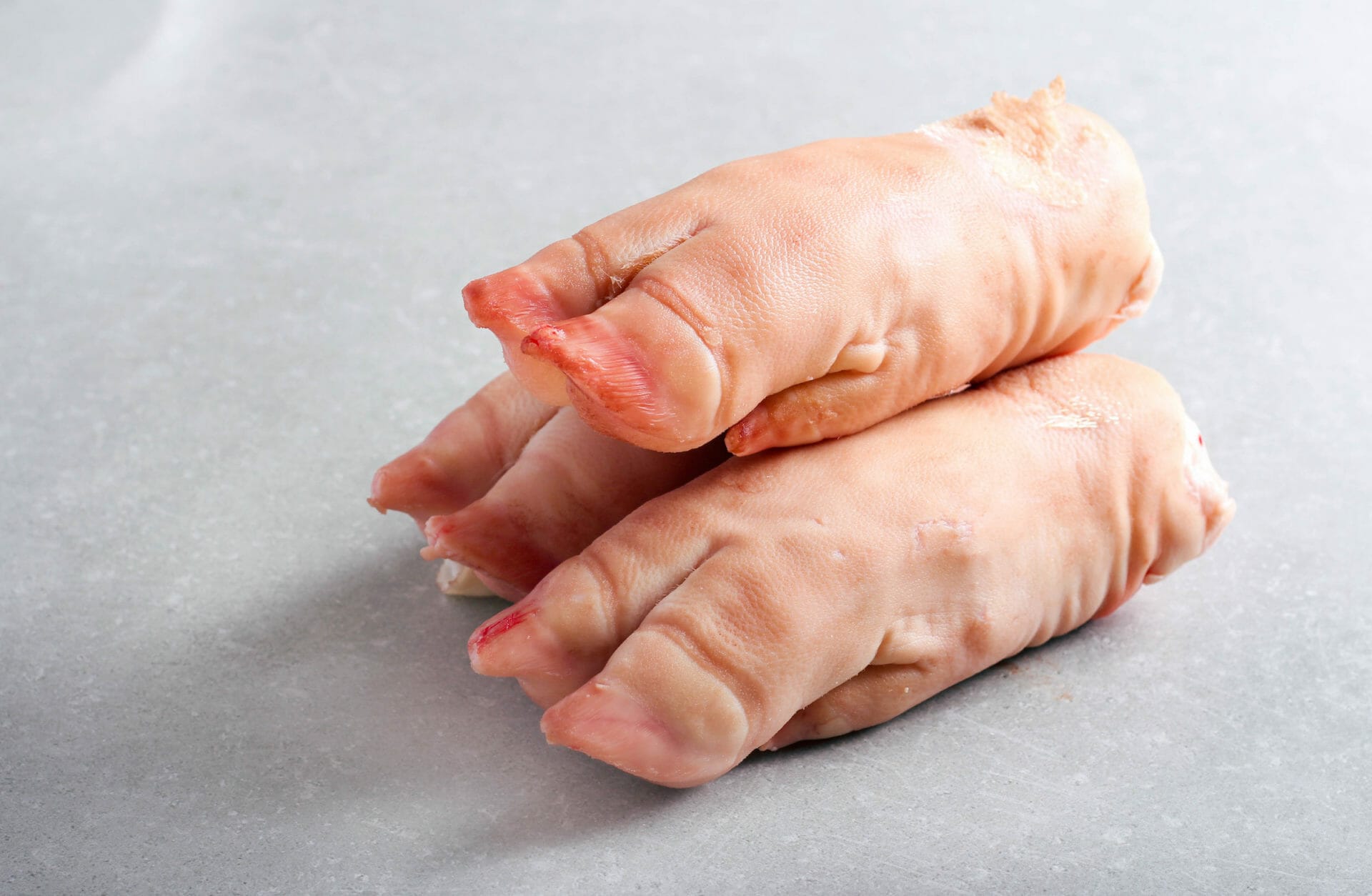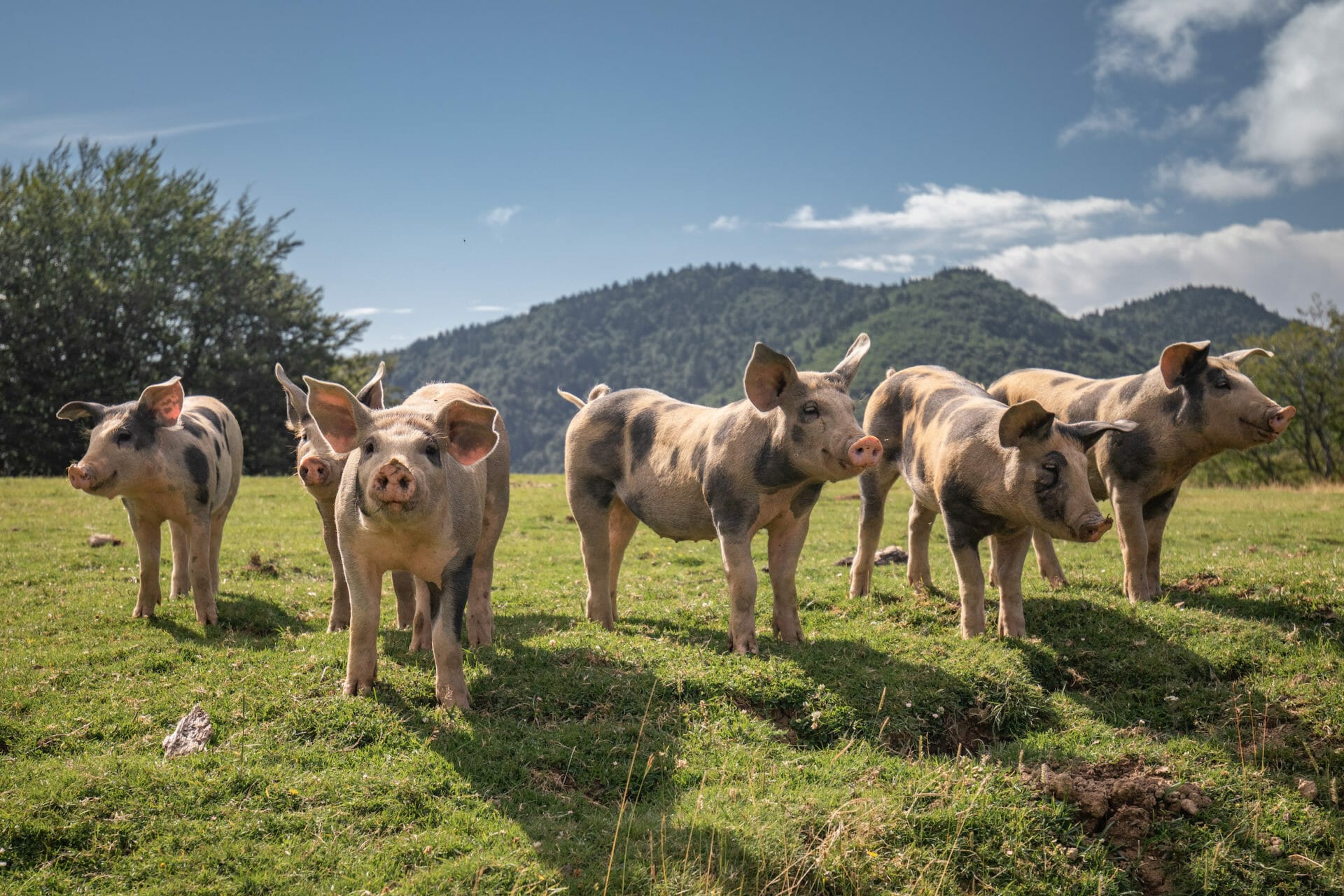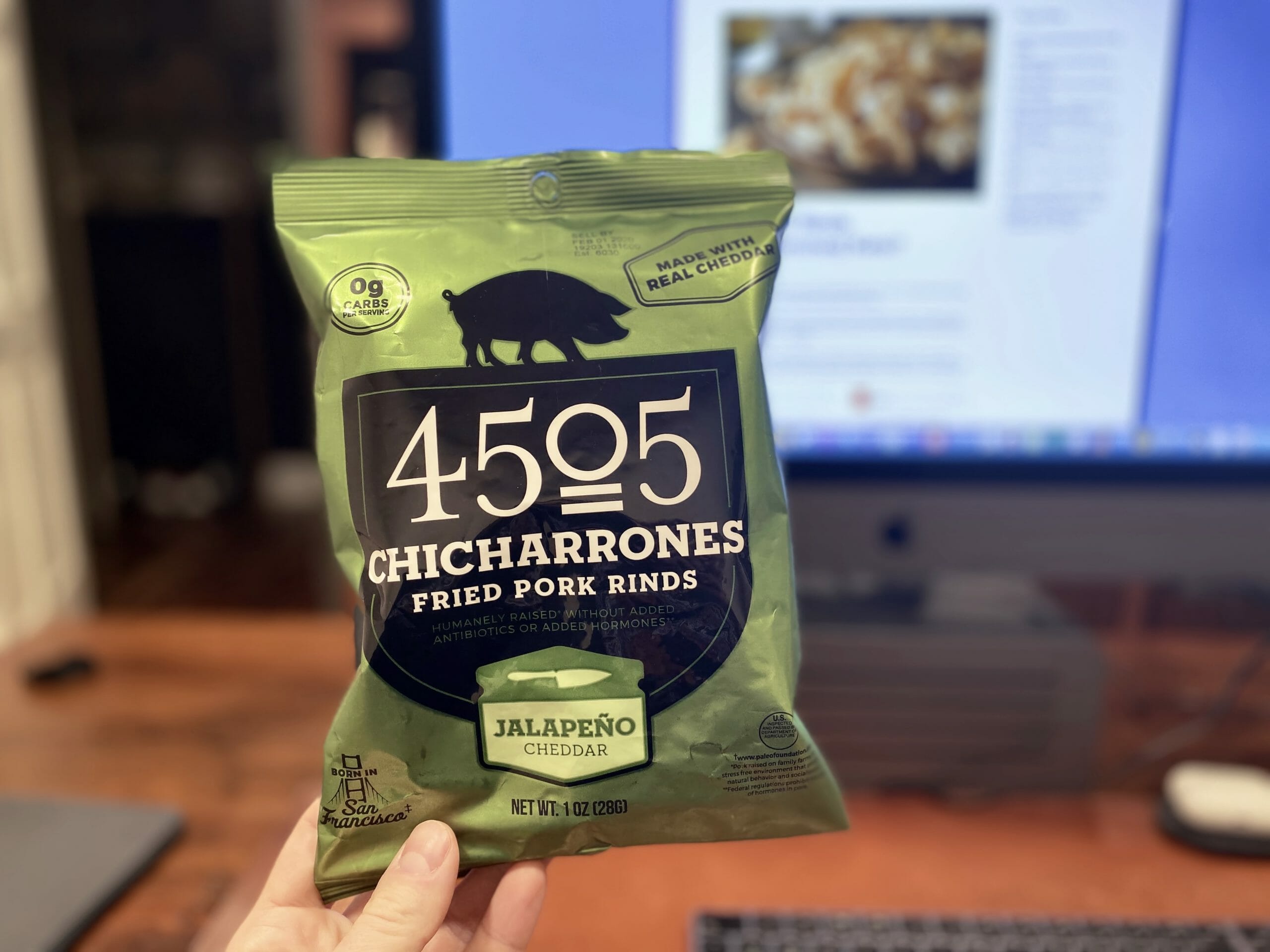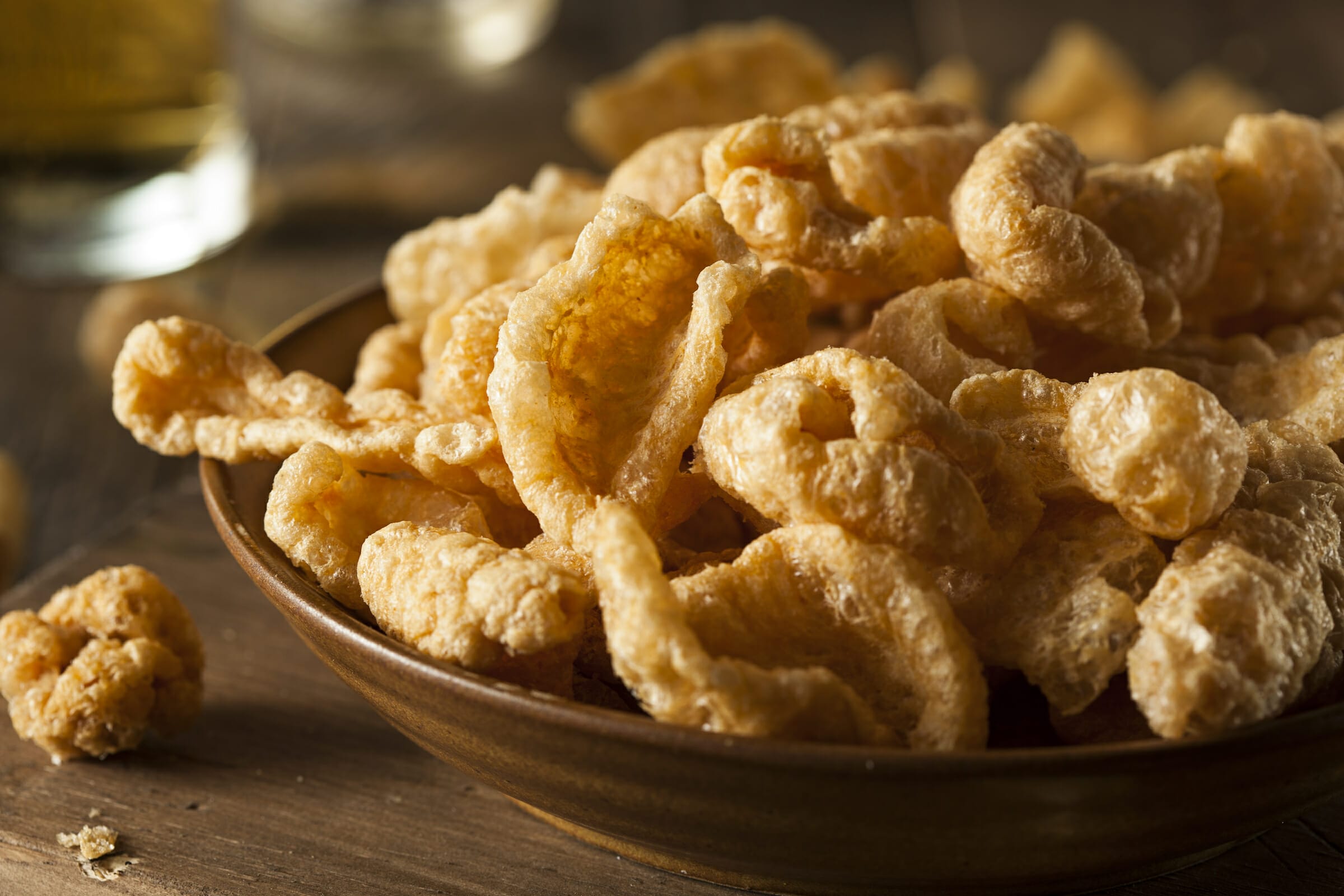Fried pork rinds, which are also known as chicharrones, are one of my favorite keto snacks because they’re high in fat and usually have zero net carbs.
Unfortunately, not all the pork rinds you’ll find in your local grocery store are created equal. That’s why it’s crucial to understand the factors that can make a naturally-healthy product — such as fried pork skin — unhealthy.
In this article, I’ll tell you everything you need to know about pork rinds and how to pick healthy products that can support your low-carb or ketogenic lifestyle. If you don’t have time to read through the full article, use the following checklist when shopping for chicharrones.
- Fried in animal fat (i.e., lard), coconut or avocado oil.
- Made from pastured or responsibly-raised pigs.
- Contains simple ingredients you can recognize.
- Fried in (hydrogenated) vegetable oils.
- Contains added sugar or artificial sweeteners.
- Artificial colors or flavors.
- Made from caged and unsustainably-raised animals.
If you decide to fry pork skins at home, apply the same principles and avoid the ingredients and oils noted above.
How Pork Rinds Are Made

Pork rinds are made from fried or roasted pig skin.
Most of the pork rind snacks you’ll find at grocery stores are seasoned and deep-fried in animal fat or vegetable oil. The type of fat used for frying is one of the major factors that determines how healthy the final product is. More on that in a bit…
Either way, the frying process makes the skin crunchy and crispy, much like potato chips.
If you want to make pork rinds at home, just buy some flaps or pork skins from your local butcher, cut them into thin strips, and deep fry them in healthy oil (again, more on that later).
Why Eat Pork Skins (and Other Animal By-Products)?

Much like feet, tails or organ meat, the skin is often considered a waste-product of harvesting an animal. In other words, if you think about eating pork, you probably think about pork tenderloin or ribs and not all the other “stuff.”
Sometimes I wonder at what point in history our society became uncomfortable eating certain parts of an animal.
From an evolutionary perspective, that hasn’t always been the case! Our Paleolithic ancestors ate animals “nose-to-tail” because they instinctively understood the nutritional value of those unpopular animal parts. Plus, they ate what they could since they didn’t know when they’d find food again.
You might be thinking, OK, but who cares? Most of us have access to plenty of food, so there isn’t a need to eat animal by-products. While that assessment might be true for chicharrones, it’s fatally flawed when it comes to organ meat.
To give you an example, one of the most nutrient-dense parts of most animals is the liver. It’s one of the primary reasons why our ancestors weren’t nutrient-deficient. Believe it or not, you can get virtually all of your vitamins and minerals from organ meat.
But when was the last time you ate liver? If I had to guess, I’d say the answer is never. Instead, we try to bridge that nutrient gap by over-consuming fruits and vegetables that are high in carbs and antinutrients, and that make us gassy and bloated.
My point is that we should embrace eating more parts of the animals we slaughter, instead of letting those products go to waste (or be made into feed for other animals that didn’t evolve to eat their cousins).
The good news is that fried pork skins are an excellent and healthy way to get started with eating parts of the pig that you might not have otherwise considered.
Are Pork Rinds a Healthy Snack for Keto?

Pork rinds can be a healthy and delicious snack for the ketogenic diet, or for any other low-carb high-fat movement.
However, the fact that a food is keto-friendly doesn’t mean it’s also healthy. How healthy or not food is depends on various factors, only one of which is macronutrient composition/fat content.
So let’s dive into the various factors that determine how healthy pork rinds are, including:
- The fatty acid composition of the animal (based on how the animal was raised).
- The type of oil or fat that was used for frying.
- Any additional ingredients (such as artificial flavors).
How Was the Animal Raised?

There’s a difference in the chemical composition in animal meat and fat depending on how an animal was raised. For example, grass-fed cattle show a much higher omega-3 to omega-6 fatty acid ratio than their grain-fed counterparts.
Without getting into the nitty-gritty of what all that means, you should know that animals are what they eat (and how they were raised), much like we are what we eat.
Animals that are fed grains to get as fat as possible in the shortest amount of time get sick (just like humans would). And that leads to low-quality meat, fat and organs.
It shouldn’t come as a surprise that parts from sick animals aren’t the healthiest food for humans. That’s why it’s important to understand how an animal was raised before you eat it.
When it comes to pork rinds, I stick with brands that use skin from naturally-raised and pastured pigs.
Aside from the health reasons, that’s also the morally right thing to do.
What Frying Oil Was Used?

There are significant differences between the various cooking and frying oils (some of which you may already be familiar with).
Vegetable oils, which are actually seed oils, are by far the least-healthy option you can choose. Unfortunately, many of those oils — such as canola, safflower and sunflower — are also the cheapest options on the market. That’s why manufacturers love using them.
The problem with those industrial oils is that you can’t extract the oil from seeds without using either high heat or harsh chemicals, both of which lead to damaged fatty acids that are incredibly inflammatory and can cause a host of metabolic diseases in the long run.
You can enjoy high-oleic sunflower oil if it was cold-pressed and carefully processed.
That’s why I recommend staying away from products that use inflammatory oils, or that don’t tell you what fat they use (which is a sure sign they’re using the cheap stuff).
As far as pork rinds are concerned, there’s no better frying oil than lard (aka, pig fat). It’s the obvious choice and my favorite. Other potentially lighter alternatives include coconut fat and avocado oil.
But if I’m choosing to eat a high-fat low-carb snack like pork rinds, I don’t want to go with a “lighter” oil.
Other Ingredients
Ideally, pork rinds shouldn’t have any additional ingredients other than seasoning and sea salt — preferably high-quality salt that contains trace minerals. That means no breading, artificial colors or flavors.
Of course, if you pick crazy flavors like Nacho Cheddar, Pizza or Salted Butter, you might a ton of extra ingredients (including artificial colors and flavors you don’t want).
I’ve also noticed that some products — including the one I prefer — list a form of sugar on the ingredient label, even though the nutrition facts claim 0 grams of sugar.
Understand that manufacturers can claim a product has 0 grams of sugar if it has less than 0.5 grams. In other words, they’re allowed to round down. That means a product can have 0.49 grams of sugar and claim 0 grams on the label.
Also, make sure that the fried pork skins you buy aren’t made with bread crumbs or other unhealthy ingredients.
My Favorite: 4505 Meats

Now that you know everything you need to know about pork rinds, you might be wondering which brand I eat.
While there are quite a few great options available on Amazon, I really like 4505 Meats. Their pork rinds and pork cracklings are all-natural, chef-crafted, and made from humanely raised animals.
4505 Meats sources exclusively from animals raised on small family ranches in low stress environments. These farmers and ranchers never use gestation crates or animal confinement practices. Animals receive protection from weather and elements. When indoors, animals have no-slat flooring and deep straw bedding. Pigs are free to move around on pasture and always have access to clean food and water. Their feed is 100% vegetarian, minimally processed, with no artificial ingredients and no paylean additives or animal bi-products.
4505 Meats
We’ve gone through almost two big cartons of those “crispy clouds of porkaliciousness” and everyone loves them (especially the kids).
Finding healthy, low-carb snacks for the little ones is a constant challenge, but chicharrones are an excellent option that’s less expensive than some of the other clean keto snacks we have in the pantry.
Besides the taste and quality of ingredients, what I like most about 4505 Meats is that they use rendered pork fat (lard) to fry the skin.
And in case you wonder about the coconut palm sugar on the ingredient label, one pork rind is 0.032% palm sugar, which is an insignificant amount in this context.
Frequently Asked Questions
Pork rinds consist mostly of the pig’s skin, with no extra fat or connective tissue. Pork cracklings contain a thin layer of fatty tissue that changes the snack’s taste and texture and increases its calories. Personally, I prefer pork cracklings because I like the taste of the extra fat.
Yes, pork rinds are as paleo as it gets — at least if the product you’re buying meets the above-mentioned quality standard.
Yes, pork rinds are naturally free of gluten. However, if you have celiac disease, I recommend you check with the manufacturer to make sure they don’t use a shared kitchen that might lead to cross-contamination from another product or production run.
Absolutely. A high-fat low carb diet like the ketogenic diet is one of the best, quickest and healthiest ways to lose weight. Just stay away from low-fat junk food and embrace healthy fats.
Not necessarily, as I explained above. The FDA labeling laws have loopholes that some manufacturers cleverly (ab)use.
Not really. You can get some Vitamin A from chicharrones, but that’s pretty much it.
Yes, most of the protein in chicharrones (and other connective tissue) is from collagen — a great source of several essential and non-essential amino acids.
Final Verdict
I’ve tried a lot of keto snacks and other keto products, and I’ve concluded that pork rinds might be the perfect keto snack. That’s because they’re high in fat and protein and have zero carbs.
Plus, they don’t require any of the non-caloric sweeteners that you might find in keto bars, nut butters and other low-carb snack options.
Pork rinds are also comparatively inexpensive because they’re made from animal by-products.
Give them a try, even if you’re not following a ketogenic diet. Pork rinds are healthy regardless of what dietary lifestyle you follow, and they’re better for your health than 99% of the other snacks you might have in your pantry.

Michael Kummer is a healthy living enthusiast and CrossFit athlete whose goal is to help people achieve optimal health by bridging the gap between ancestral living and the demands of modern society.
Medical Disclaimer
The information shared on this blog is for educational purposes only, is not a substitute for the advice of medical doctors or registered dieticians (which we are not) and should not be used to prevent, diagnose, or treat any condition. Consult with a physician before starting a fitness regimen, adding supplements to your diet, or making other changes that may affect your medications, treatment plan or overall health. MichaelKummer.com and its owner MK Media Group, LLC are not liable for how you use and implement the information shared here, which is based on the opinions of the authors formed after engaging in personal use and research. We recommend products, services, or programs and are sometimes compensated for doing so as affiliates. Please read our Terms and Conditions for further information, including our privacy policy.

4505 are great but hard to find and can be pricey…
There are some articles online stating that pasture raised pigs getting plenty of sunshine have high levels of vitamin D stored in their fat. Do you think cracklings could be a good source of Vitamin D?
Hi JTD,
None of the products I’ve seen list Vitamin D on the nutrition label. I haven’t even seen Vitamin D mentioned on the pastured lard we use. So this might just be an omission by the manufacturer. Technically, both pasture-raised lard and cracklings should have Vitamin D.
Cheers,
Michael
Have you tried EPIC oven baked Pink Himalayan & Sea Salt Pork Rinds? They are very good, and have 40% less fat than fried rinds. They meet all your criteria, ie: organic, pasture raised, no antibiotics, limited ingredients … only pork fat and sea salt! I have no interest in the company that makes these, I am only a consumer.
Hey Connie!
I’ve tried EPIC and like them too but I prefer more fat over less :)
Cheers,
Michael
I live up in Canada, and there’s a family business here that makes pork rinds from “traditionally raised pork” and fries them in lard in small batches. They’re expensive, but amazing. I’m kind of addicted.
My question is: how’s the stearic acid to linoleic acid balance in pork rinds fried in lard? Paul Saladino has theorized that it’s too much linoleic acid in our diets that is causing a lot of the metabolic and possibly auto-immune problems we see today.
Hi BD,
pork fat (lard) has predominantly saturated and monounsaturated fatty acids with only low amounts of polyunsaturated fatty acids. In my opinion, PUFAs and, in particular, omega-6, are as bad as sugar. But considering the low amounts present in lard, I wouldn’t be too worried about consuming pork rinds.